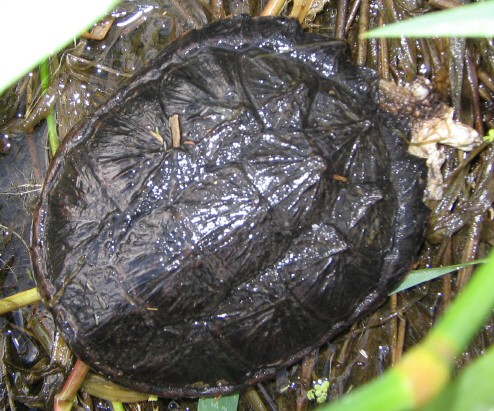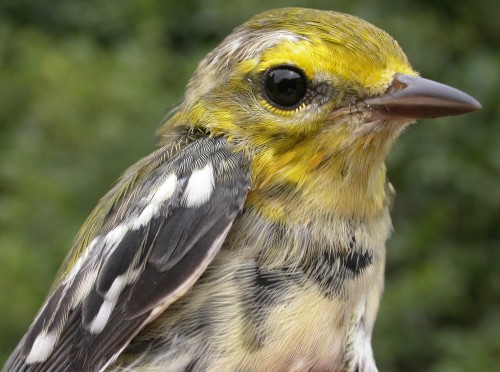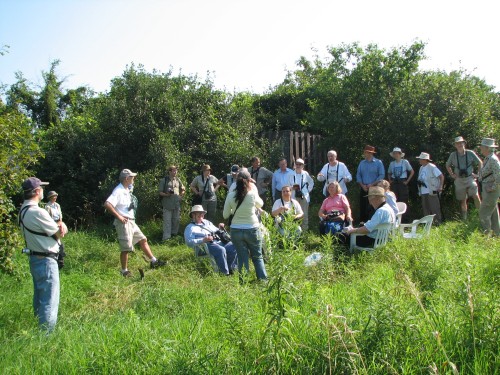June 6 – 30, 2006
|
|
| THIS WEEK | THIS SUMMER | 2006 TOTAL | SITE TOTAL | |
|---|---|---|---|---|
| # birds (and species) banded | 6 (1) | 6 (1) | 908 (69) | 5961 (95) |
| # birds (and species) repeat | — | — | 235 (27) | 1113 (42) |
| # birds (and species) return | — | — | 96 (20) | 165 (25) |
| # species observed | 52 | 52 | 152 | 178 |
| # net hours | — | — | 3033.5 | 9455.6 |
| # birds banded / 100 net hours | — | — | 29.9 | 62.9 |
Note: table does not include nocturnal banding (owls).
Bander-in-charge: Marie-Anne Hudson Assistants: Gay Gruner, Betsy Mcfarlane, Barbara MacDuff, Chris Murphy
Notes: As expected, June was a quiet month at MBO. Our first census of the summer season was conducted on the 9th of June, and they’ve been going about twice a week since then thanks to our loyal censusers (please see above). The average number of species seen during each visit ranged between 28 and 39, however the total number of species observed during the month of June was a respectable 52. We even managed to scrounge up a new species for the year, an American Woodcock flushed from the reeds past C. In terms of unusual species for MBO, a couple of Purple Martins were spotted on census, and a Black-and-white Warbler may have stuck around to breed, though it was only heard once.
It’s understandable that things have quieted down considerably, as most of the birds that have remained at MBO have settled down to breed. Most noticeably, the Common Yellowthroats have almost completely ceased singing, opting instead to skulk around the bushes and ‘cheack’ at you as you walk by. The Rose-breasted Grosbeaks and Warbling Vireos, once so vocal it was hard to hear anything else, have fallen completely silent. We’ve certainly noticed the results of this year’s breeding season with some excitement: young Wood Ducks have been peeping in the ponds, 2 young Blue Jays were seen with a parent, young American Robins and Red-winged Blackbirds abound (making for some very aggressive parents), and young House Sparrows, Veerys and Baltimore Orioles have been either lurking in the shrubbery or loudly demanding food. We also had the opportunity to band 6 young Tree Swallows, quite possibly some of the squirmiest little birds we’ve handled in a while.
This month’s top 10 [last week of spring’s rank in brackets]
The ten species most frequently observed this week were roughly the same as the last week of the Spring season, though their order of abundance changed considerably. While Red-winged Blackbirds continue to dominate, several species moved up in the rankings this week, such as Yellow Warbler, American Goldfinch, Tree Swallow, Song Sparrow, and Ring-billed Gull. The complete disappearance of our local Canada Geese made room for several new additions to the list, however the tie in number made the list too long to include in the table itself: Mallard (well, not completely new…), Black-capped Chickadee, American Robin, Common Yellowthroat and Common Grackle. What about the other species at MBO? Well, we’ve got a raccoon family of 3 little ones on the trail linking Mosquito Alley to B, and a Skunk that REALLY doesn’t like being watched (MAH discovered this as she was attempting to identify a small duckling hiding in some reeds, completely unaware that the skunk was unhappy she was walking back and forth in front of its hiding spot – needless to say once the skunk made its presence known, MAH quickly retreated). The vegetation has really gone wild, with some of the grasses in the meadow now taller than most of us (but probably not Marcel). We hope to continue censusing throughout July, and will begin to gear up for the upcoming fall season soon. Last but not least, today (June 28) two more species were added to this summer’s list – a Northern Harrier, and an Osprey flying over, carrying a massive fish!
July 1 – 31, 2006
Note: table does not include nocturnal banding (owls). Bander-in-charge: Marcel Gahbauer, Marie-Anne Hudson, Barbara Frei Assistants: Averill Craig, Jean Demers, Isabel Julian, Gay Gruner, Betsy Mcfarlane, Barbara MacDuff, Chris Murphy, Clémence Soulard Notes: July was a month of heat, humidity and storms! Despite the weather, we had 12 days of observation, 4 days of banding, and several days of site maintenance and prep work for the upcoming fall season. The number of species seen during each visit ranged between 23 and 42, with the average hovering around 32. The total number of species seen over the entire summer, however, stands at 65 (61 seen this month). One new species has been added to the 2006 list: a Marsh Wren was heard burbling away on the far side of Stoneycroft during the census walk on the day of the Bird Protection Quebec field trip (more on that below). Over the course of July, 15 species were added to this summer’s list: American Black Duck, Red-tailed Hawk, Merlin, Chimney Swift, Yellow-bellied Sapsucker, Least Flycatcher, Barn Swallow, Common Raven, House Wren, Marsh Wren, Tennessee Warbler, Black-throated Green Warbler, Ovenbird, Savannah Sparrow and White-throated Sparrow. In terms of unusual species at MBO, a Merlin zipped over the D nets being chased by an Eastern Kingbird, and a House Wren was making a fuss while its hatch-year companion was stuck in D2. We had breeding House Wrens last year, but until now there’s barely been any sign of them! It’s always surprising to have young birds pop up that have clearly been raised on site when there hasn’t been any sign of breeding activity. The Bird Protection Quebec field trip was a wonderful experience. We were lucky enough to have beautiful weather for our 30 visitors. Unfortunately, beautiful weather for birders is not the same as beautiful weather for banders. The bright sunshine made the nets stick out like sore thumbs, and the heat kept bird movement to a minimum, making for a catch of 1 lonely little Song Sparrow. But at least we weren’t left completely empty handed! The other 3 days of banding in July proved to be more productive, with 26 birds banded representing 10 species, 3 of which were new for 2006: House Wren, Black-throated Green Warbler, and Ovenbird. The after-hatch year male Black-throated Green Warbler, as well as a heavily-moulting after-hatch year male Tennessee Warbler (netted but not banded), are sure signs that fall migration is gearing up! Factoring in owls (not included in the table above), we banded our 6000th bird last week – a Song Sparrow, as several of our other milestone birds have been. We can’t wait to see what we’ll be banding over the coming weeks!
|
 The only birds banded this month were 6 Tree Swallow chicks in one of the MBO nest boxes
The only birds banded this month were 6 Tree Swallow chicks in one of the MBO nest boxes
 This Black-throated Green Warbler, banded July 26, is likely one of our first southbound migrants. (Photo by Marcel Gahbauer)
This Black-throated Green Warbler, banded July 26, is likely one of our first southbound migrants. (Photo by Marcel Gahbauer) About 30 members of Bird Protection Quebec came for a visit on July 29, 2006. Though only 1 bird was netted, everyone seemed to have a great time walking the census route and doing general observations. (Photo by Barbara Frei)
About 30 members of Bird Protection Quebec came for a visit on July 29, 2006. Though only 1 bird was netted, everyone seemed to have a great time walking the census route and doing general observations. (Photo by Barbara Frei)